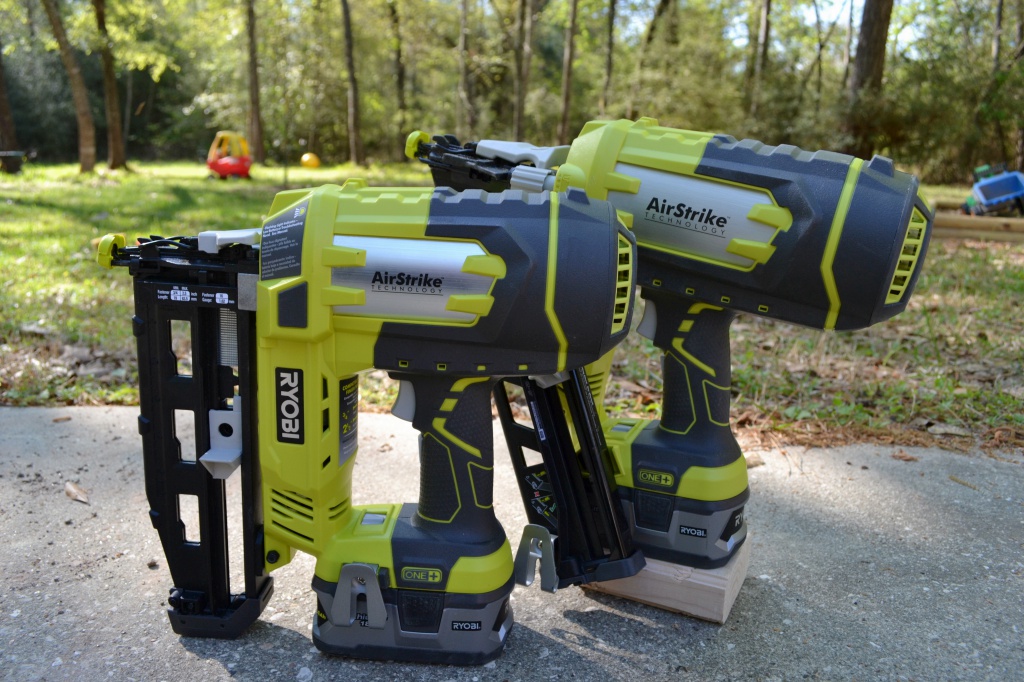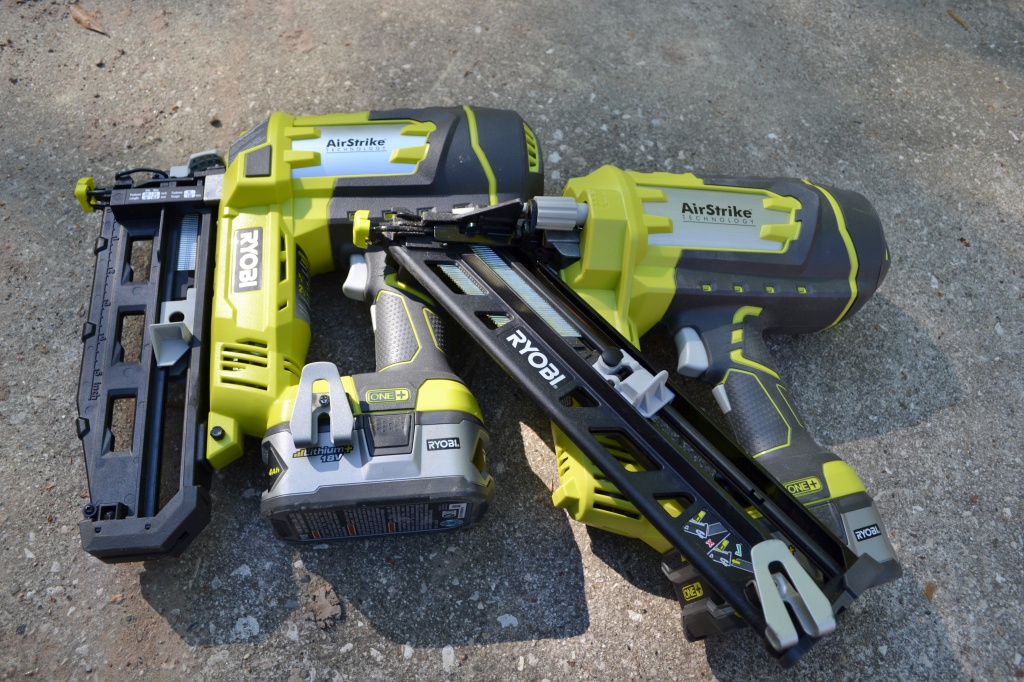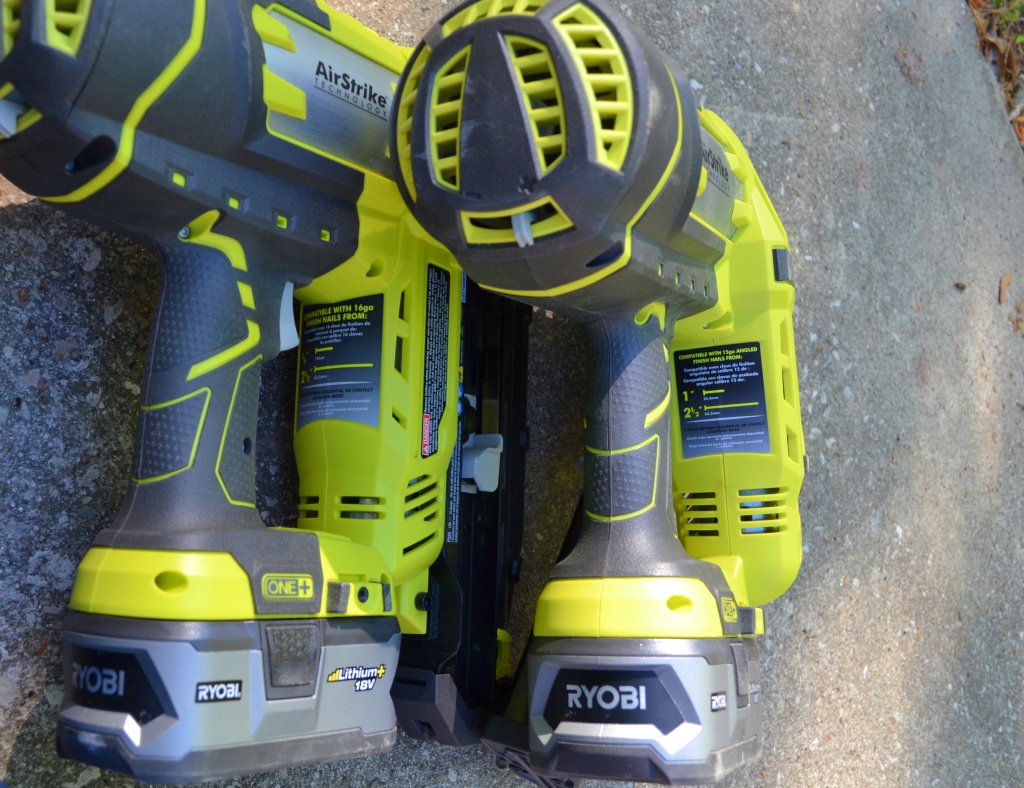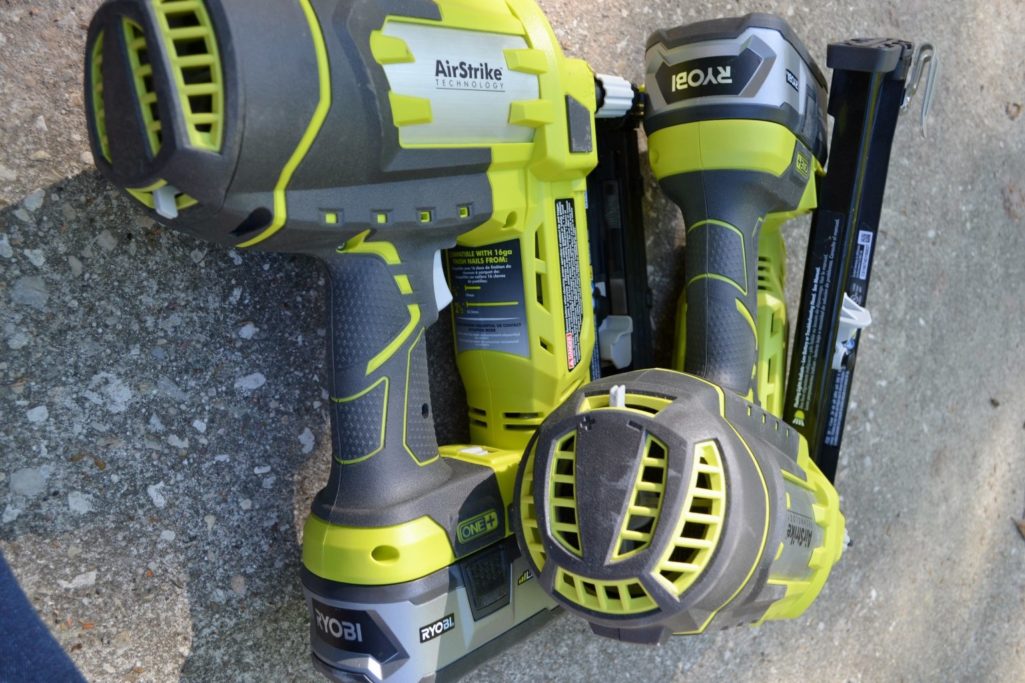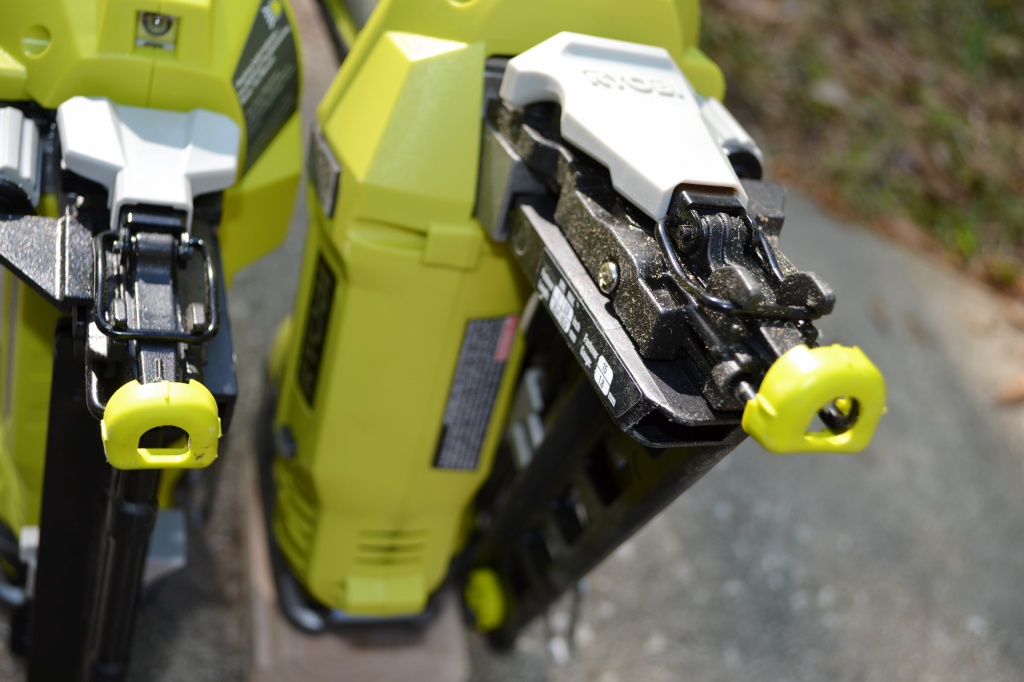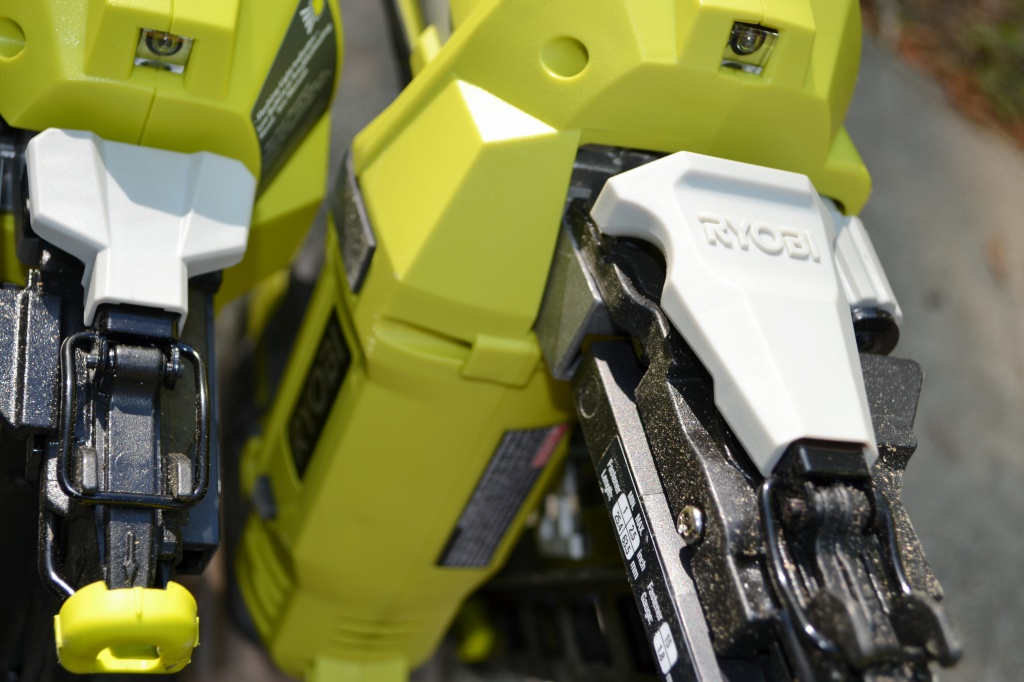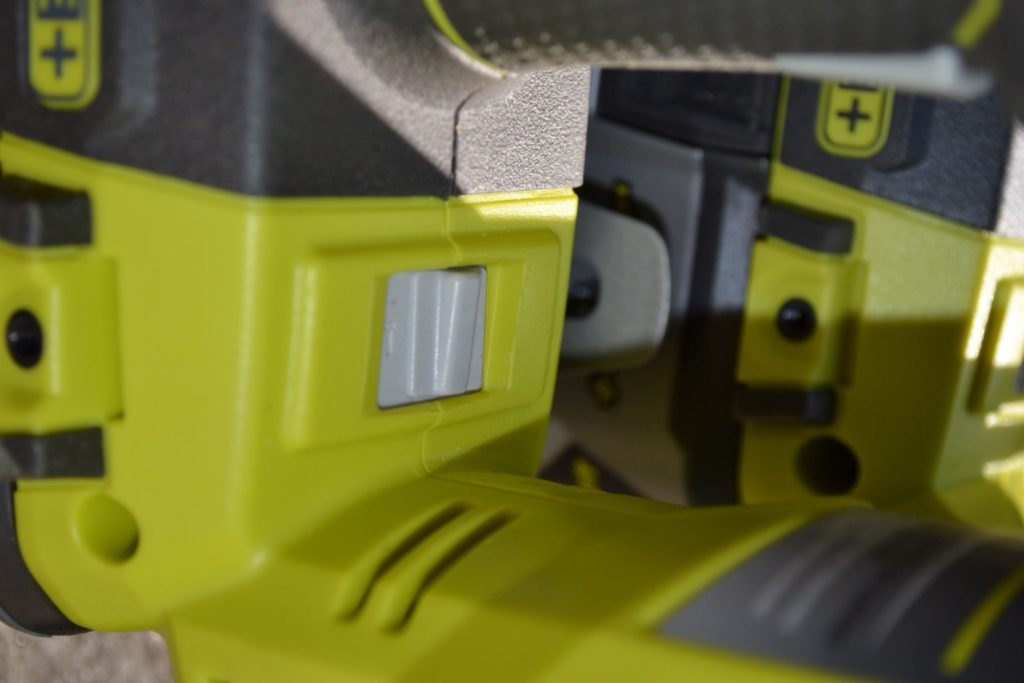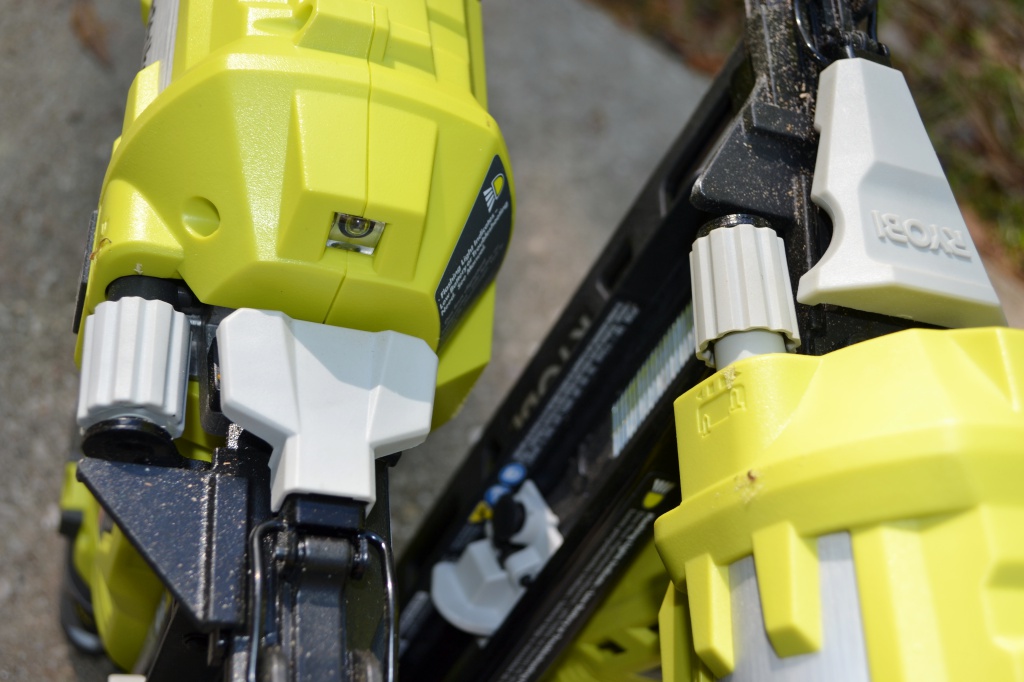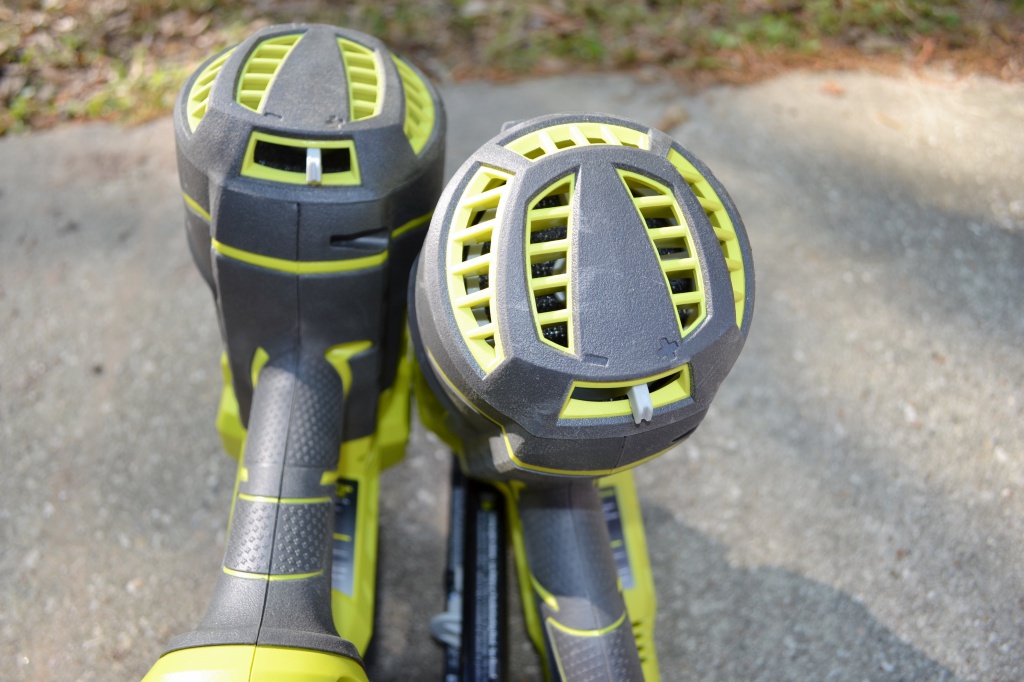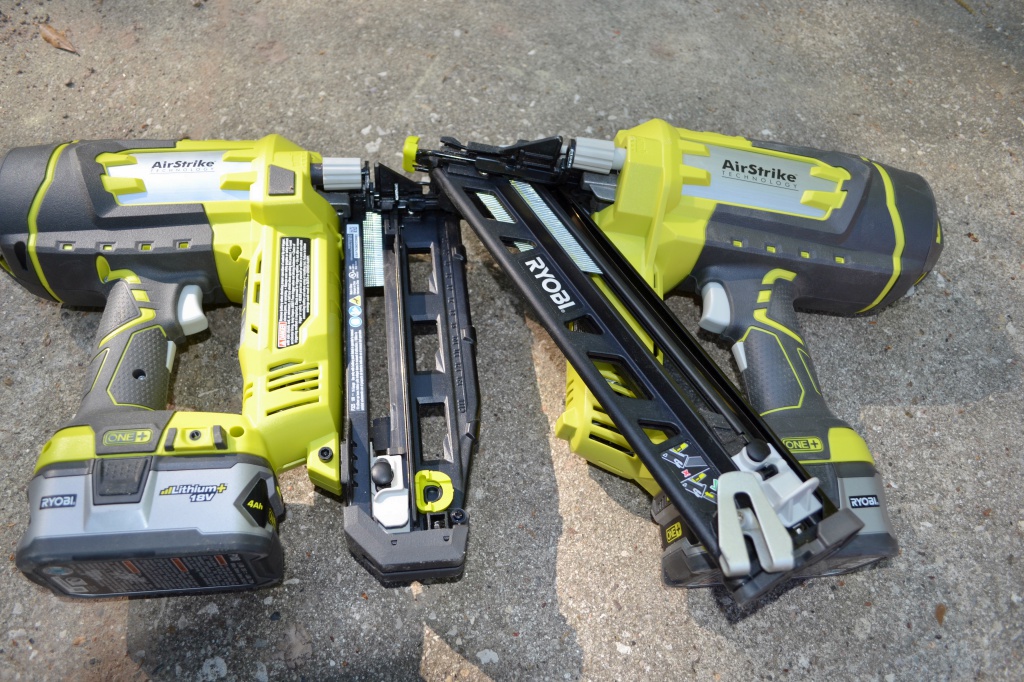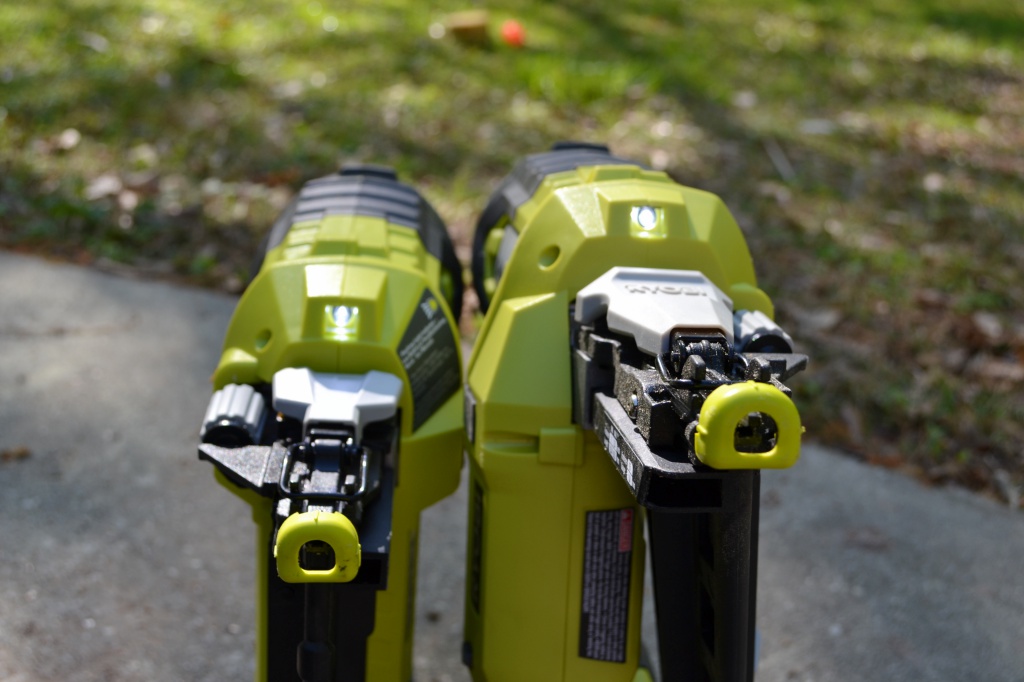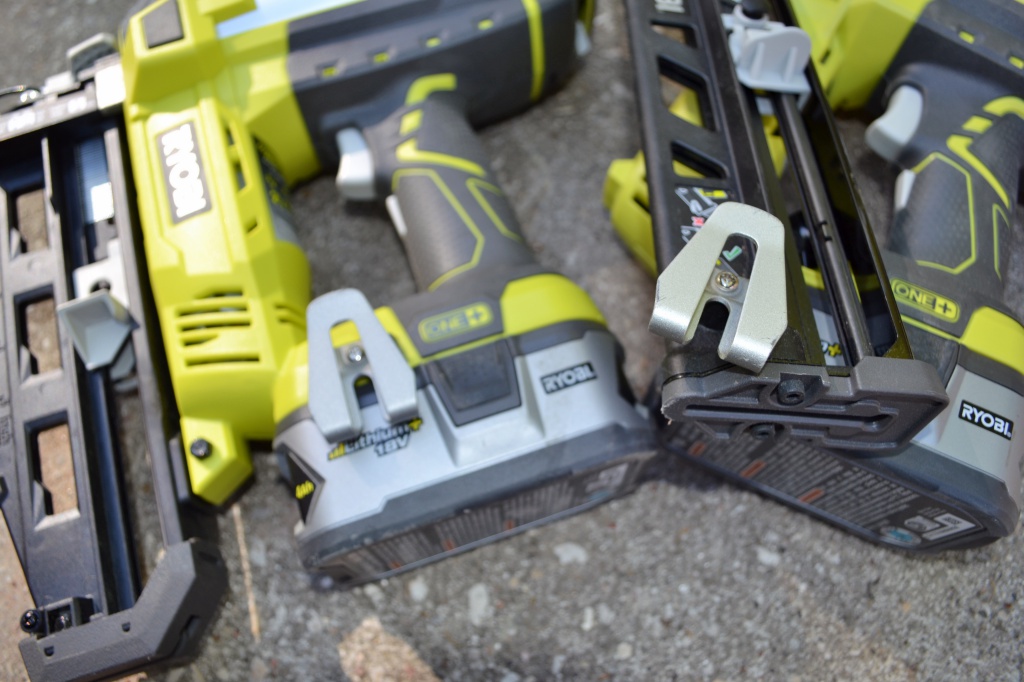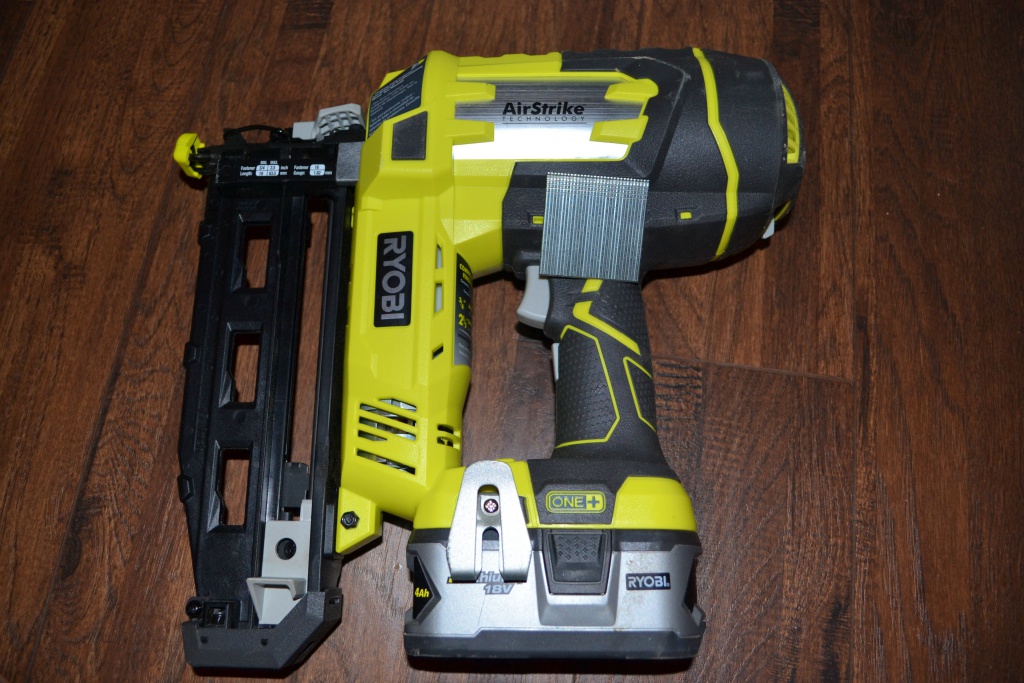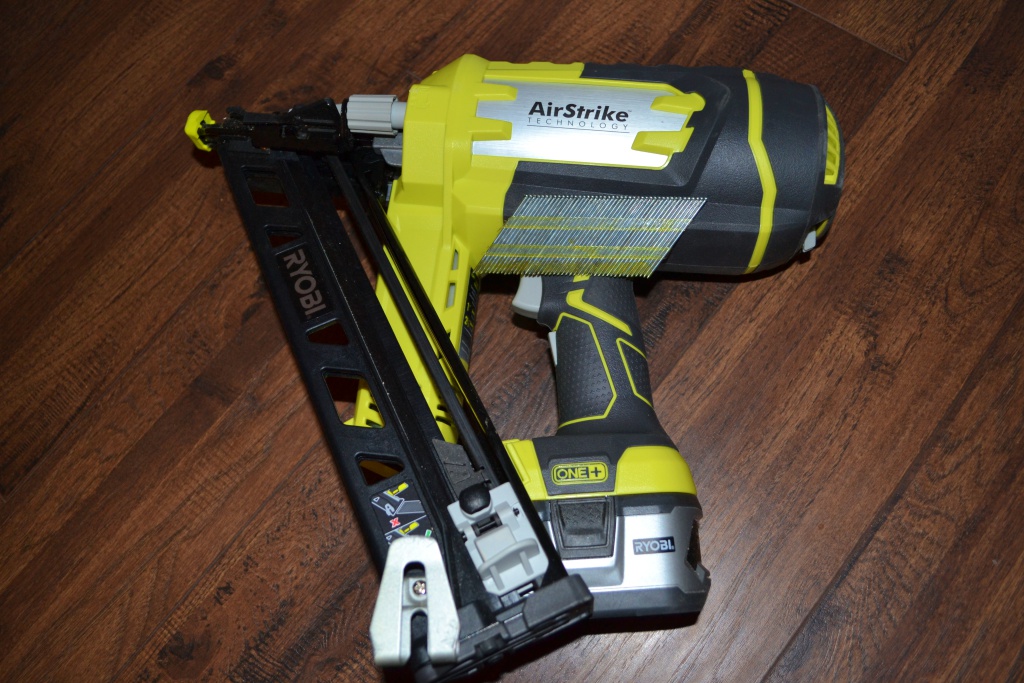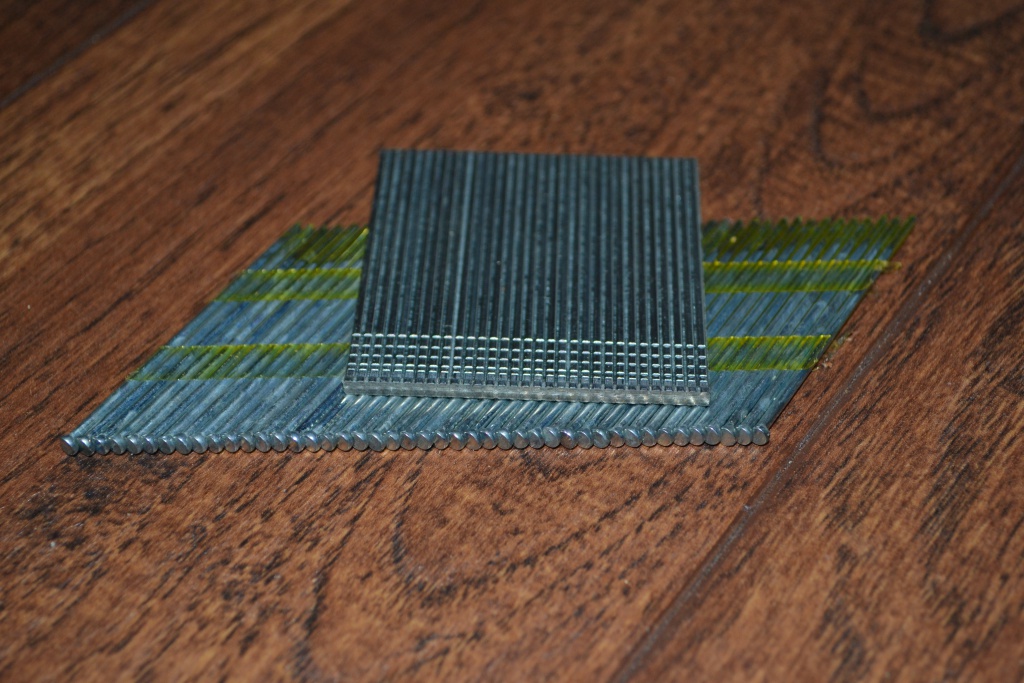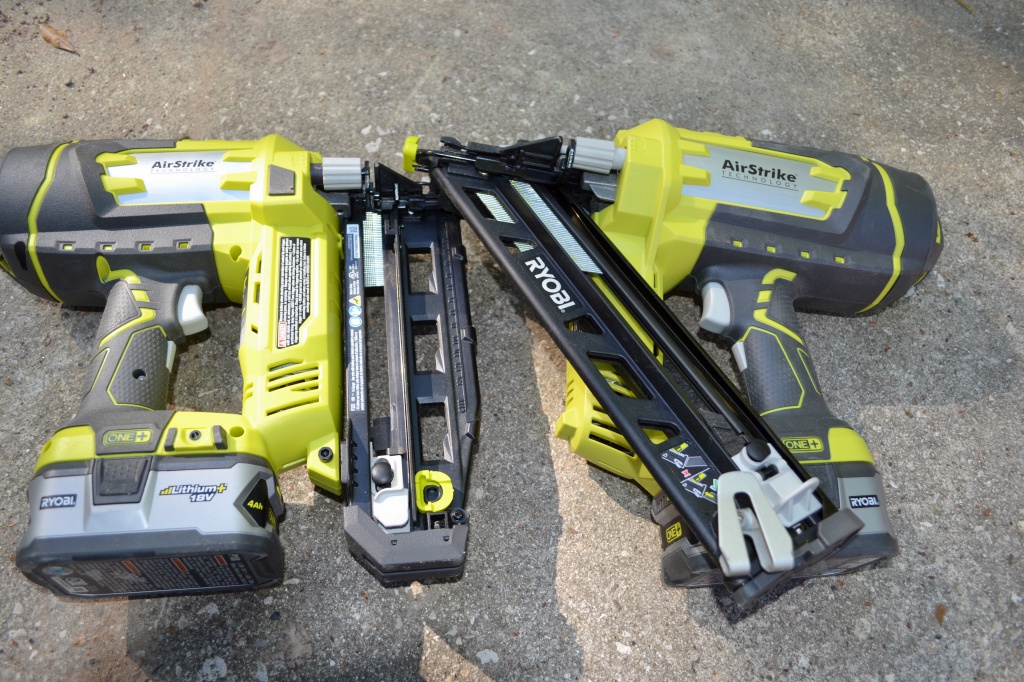It comes as no surprise that I am a fan of the Airstrike line of Ryobi Cordless Nailers. I have picked these apart endlessly trying to find something wrong with them, and honestly, I just can’t come up with anything to say that is significantly negative. Ryobi seems to always be looking ahead, and their future led thinking is evidenced by the large cordless lineup that homeowners and hobbyist flock too. Ryobi offers two different Finish Nailers in their Airstrike Cordless lineup, a Straight Finish Nailer, and an Angled Finish Nailer. Both have advantages over the other and have their unique purposes in a tool collection and it becomes a matter of use and preference to which will suit your needs most. Let’s dig a bit deeper and check out the Ryobi Cordless Finish Nailers.
Ryobi Cordless Finish Nailers Review Overview
Finish Nailers are instrumental to a homeowners arsenal. Unless you are doing framing or building heavy structures, a finish nailer is likely the largest nailer you will own. From furniture building, home improvement projects and a range of odd jobs around the house I get a lot of use out of Finish Nailers. Finish Nailers may have been around for a long time, but that didn’t stop Ryobi from taking a classic tool and improving it. With Ryobi offering two different versions, an Angled Finish Nailer and a Straight Finish Nailer you can certainly find the perfect fit for your needs.
Ryobi Cordless Finish Nailers Review Features
Ryobi kept a lot of key features between these two nailers, so let’s talk about their similarities first. Both Nailers feature a brushless motor for extended tool life and optimum battery performance.
Both Ryobi Cordless Finish Nailers run on the 18V ONE+ battery platform.
The Ryobi Nailers have a standard trigger that is set to perfect sensitivity, as well as Ryobi’s GripZone over mold for increased comfort during use.
The Nailers feature non-marring pads to prevent damage to workpieces during use.
The Tool-Free jam release is easy to operate by a simple latch. This is useful if you encounter a jam while working, allowing quick recovery time. I will say, this feature is a must on newer nailers, but with all of the Ryobi Nailers I haven’t had a jam to clear yet!
The Nailers have a selectable drive switch allowing a user to switch between Single Sequential Actuation mode or Rapid Contact Actuation mode for enhanced speed placement.
The tool-free depth of drive adjustment knob allows for adjustments to be made to the nail settings based on user needs.
The adjustable air pressure dial is located on the back of the nailer and increases customization for the user, mimicking the traditional use of a compressor.
Both Nailers have a bottom loading magazine, allowing you to pull the release down, insert nails and depress the black button on the release to engage the pressure on the actual nails. As well, both Nailers have a dry fire lockout feature and a low nail indicator to prevent the tool from both damaging the workpiece and extends tool life.
The LED lights are a nice touch to properly light a workpiece for optimum visibility.
Both of the Ryobi Cordless Finish Nailers have included belt clips.
Ryobi Cordless Straight Finish Nailer
The Ryobi Cordless Straight Nailer is named so because the magazine runs straight. They are probably the most recognizable nailer and are definitely a staple in any contractors kit as well as a homeowners first nailer purchase. The bare tool retails for $199.00 (model #P325).
The Straight Nailer shoots 16GA nails ranging from 3/4 to 2-1/2 inch nails. The heads are simple T-shaped and are relatively easily hidden if need be. The magazine can hold 100 nails at a time, a total of 800 per charge.
The Straight Nailer measures 12.75 inches tall by 11.61 inches wide and is 4.13 inches deep. It weighs in at 6.15 pounds without a battery.
Ryobi Cordless Angled Finish Nailer
The Ryobi Cordless Angled Finish Nailer similarly gets its name from the magazine style, running at an angle.
The Ryobi Cordless Angled Finish Nailers uses 15GA nails with a D-Shaped head ranging from 1 to 2.5 inches. The magazine can hold 105 finish nails at a time and can shoot 750 per charge.
The Angled Finish Nailer is larger, measuring in at 14.65 inches tall, 16.46 inches wide and 6.06 inches deep making it quite a bit larger than the Straight Nailer. It is also slightly heavier, weighing in at 6.8 pounds.
Ryobi Cordless Finish Nailers Differences
There are a few main differences that will help determine which nailer will best suit your needs. The first being nail size and shape. The Angled Finish Nailer uses slightly thicker nails at 15GA vs the Straight Nailers 16GA. The Angled Nailers nails also have a larger head being a D-shape vs a T-shape. The larger nails pose an advantage in more holding power, and the head shape lends itself to that as well because of the increased coverage. The main negative would be that they are harder to cover the heads and pose a higher risk of splitting when using delicate wood.
The cost of nails also varies some. A box of DeWalt 2.5 inch angled finish nails would run about 25 dollars for a box of 2500. A similar box of 2500 2.5 inch straight finish nails from DeWalt is somewhat cheaper at about 20 dollars. There are tons of nail brands out there, I picked a well-known company to compare but generally, the angled nails will run a bit more.
The Angled Nailer is larger and somewhat heavier, but the angled magazine makes it easier to fit into tight spaces. The Angled Nailer also has a slightly longer nose, increasing even further its advantages in small spaces and tight corners.
An Angled Nailer also increases accuracy as well. Because of its ability to be maneuvered in tight spaces, it also increases its ability to be accurate as a Straight Nailer doesn’t have the same maneuverability because of its longer front end.
Generally, a Straight Finish Nailer would be heavier than an Angled, but this isn’t the case with the Ryobi’s. I like that the Straight Finish Nailer is somewhat more compact and for me, that weight change does make it slightly easier to use. This won’t carry the same benefit for everyone, but I am not exceptionally strong and the slight increase in size and weight made a difference in comfort for me.
Ryobi Cordless Finish Nailers Review Performance
Ryobi has yet to disappoint me in terms of performance. No tool company gets it right 100% of the time, but so far Ryobi has been right on the money. The Ryobi Cordless Finish Nailers have absolutely replaced my previous compressor powered nailers. The simple features like their seamless magazine load or the LED lights make working with the Nailers a breeze. Often times people mention delays in working with cordless nailers in general, and while you could occasionally see a split second delay after an intense run, it has not been an issue for me at all. In fact, I found it less significant than the delays seen with compressor powered nailers previously.
Ryobi Cordless Finish Nailers Review Value
Both Ryobi Cordless Finish Nailers, ( Straight is model #P325 and Angled is model #P330) both retail for $199.00. A lot of the value of cordless tools is the convenience, and these are no exception. After years of using pneumatic nailers and hassling with a compressor to do so, I can’t imagine going back. Ryobi is known for their value priced tools and comparing other cordless finish nailers Ryobi again kept their price point significantly lower without sacrificing features or performance. There is no doubt that the Ryobi Finish Nailers are some of the best values I have seen in the cordless lineup.
Ryobi Cordless Finish Nailers Final Thoughts
Ryobi thought these two tools out well. Both Nailers are heavy on features but light on the budget. If you’re looking to decide between the two, I would ask yourself what you need the nailer for primarily. The Angled Nailer has a slightly bulkier build but can squeeze into small corners and awkward spaces because of its shape. Despite its bulkier body, it’s weight is still well balanced which keeps it still comfortable. The Straight Finish Nailer is lighter and slightly more compact, but you sacrifice a bit of strength to smaller nails. Smaller nails do equal better hide, so it’s all a matter of balancing priorities. I have used both nailers pretty consistently over the last couple of months and they both get the job done with ease. No matter which direction you go, both Ryobi Finish Nailers are a great choice and will easily find their place in your shop.

